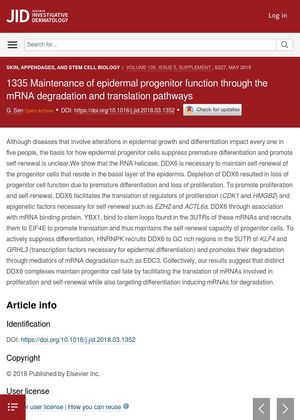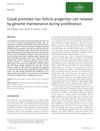Maintenance of Epidermal Progenitor Function Through the mRNA Degradation and Translation Pathways
April 2018
in “
Journal of Investigative Dermatology
”

TLDR The protein DDX6 helps keep skin cells renewing properly by controlling the production of certain other proteins and breaking down those that cause cells to mature too quickly.
The 2018 study found that the RNA helicase, DDX6, is crucial for maintaining the self-renewal of progenitor cells in the basal layer of the epidermis. When DDX6 was depleted, there was a loss of progenitor cell function due to premature differentiation and a decrease in proliferation. DDX6 promotes the translation of regulators of proliferation (CDK1 and HMGB2) and epigenetic factors necessary for self-renewal such as EZH2 and ACTL6a. It does this by associating with the mRNA binding protein, YBX1, and recruiting them to EIF4E to promote translation. To suppress differentiation, HNRNPK recruits DDX6 to GC rich regions in the 5UTR of KLF4 and GRHL3 (transcription factors necessary for epidermal differentiation) and promotes their degradation through mediators of mRNA degradation such as EDC3. The study concluded that distinct DDX6 complexes maintain progenitor cell fate by facilitating the translation of mRNAs involved in proliferation and self-renewal while also targeting differentiation inducing mRNAs for degradation.

